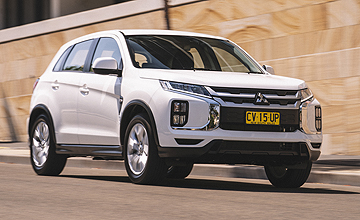
Overview
EVERY decade seems to have its standout hit that resonates with the buying public – Chrysler Sigma (1970s), Ford Falcon (1980s), Hyundai Excel (1990s), Mazda3 (2000s) … and for this dying decade, it must surely be the Mitsubishi ASX.
Launched in July 2010, the Lancer-based crossover snuck in and sold indifferently at first, but as improvements arrived with successive updates its grip on the Small SUV class tightened.
Facelifted for the third time, the XD-series for 2020 attempts to maintain the number one sales spot with a fresh new look, but can it appease critics who’ve long decried the ageing warhorse’s dreary performance, tired dynamics, dated cabin and patchy refinement?
Drive impressions
MITSUBISHI has become the envy of the Australian car industry, as the Japanese brand continues to defy logic (and trends) by increasing its sales share in a depressed market with mostly older models like the ASX.
Obviously, there’s some deft sales and marketing going on, but consumers have to like what they see, and – as the number one small SUV in Australia – the ASX in particular is clearly beloved by buyers.
‘Seeing’ is the key. Handsome, well proportioned, comparatively spacious, well equipped and simple to understand, the old Lancer-based crossover wagon usually has them won over early on the showroom floor before the first drive, and then seals the deal by being completely undemanding behind the wheel.
Throw in Mitsubishi’s hard-earned reputation for reliability and durability, and the ASX really is like comfort food for many thousands of Australians. The spaghetti Bolognese of small SUVs.
But how does a model the world first saw in December 2009 feel and drive on the eve of 2020?
Surprisingly, first impressions are strong, thanks to a very impressive modern nose graft that looks even better in the flesh than in photos.
Same goes with the tail-light lens makeover. These, in concert with the sporty blacked-out MR and GSR newcomers, should really lure in some of the male demographic that Mitsubishi Australia is so longing for.
Throw in the long warranty, keen driveaway pricing and catchy advertising jingles the company is so fond of using, and we can see the ASX retaining its perch on top of the small SUV tree.
But only if completely honest and undemanding motoring is at the heart of your new-car needs, because – frankly – the moment you sit inside one, the ASX looks, feels, sounds and drives like the decade-old jumped-up Lancer it is.
Take the interior architecture. Hardy, sensible and familiar it may be, with a larger touchscreen than ever before in this series.
But the dash is about as contemporary as an iPod. The dials and graphics seem inspired by the 2003 Mazda3’s, with no digital speedo to aid the driver in this era of speed-camera oppression.
The seats are set too high and don’t offer enough comfort or support over long distances; though new, the touchscreen is fiddly to use on the go; and some switchgear are quite a stretch away.
We know Mitsubishi can do modern interiors. Just look at the Eclipse Cross as an example of how it should be done.
Oh well, at least the new powertrain might redress that, right? Wrong.
Though some 400cc larger than the 110kW/197Nm 2.0-litre atmo four that continues in the ES, MR and LS variants, the 123kW/222Nm 2.4-litre unit as sampled in the Exceed doesn’t really seem that much of a step up.
Perhaps that has more to do with the smooth but relaxed CVT auto, which responds well off the line and delivers its power to the front wheels with dependable consistency, but there isn’t any more discernible punch or oomph if you press down hard on the accelerator compared to the continuing old 2.0L.
Instead, like its smaller brethren, the engine just drones away, loudly and with little spark or joy. Again, unlike the Eclipse Cross alternative with its gutsy 1.5L turbo.
At least the 2.4L feels unburstable, like it could go on forever.
We’re no fans of the steering, which also is a little too light, lifeless and remote for our taste, but the ASX really stumbles badly with an inability to suppress bumps of any size and shape, electing instead to transmit them (as well as road thrum) into the cabin with depressing regularity.
The result makes for a noisy, unsettled and fatiguing ride over the straights, combined with little cornering finesse along the bends, that can lead to not enough body control (and a whole lot of motion sickness to boot).
They make look great on the dealer forecourt, but those 18-inch alloys and accompanying 225/55R18 tyres struggle to contain the commotion.
What we’re left with, then, is a revised ASX that might look the part, but the ageing cabin and underpinnings struggle to keep the façade fresh in the harsh light of the new decade.
The MY20 version continues to feel and drive like the old Mitsubishi that it is.
The base ES at a mid-$20K driveaway price makes sense for its sensible specification and improved safety, but beyond that, the ASX now feels outclassed.
Despite all the MY20 changes, we’re all out of love for the ASX and after driving in the alternatives, maybe Australian buyers might be as well.
Please consider the far-more modern Mitsubishi Eclipse Cross instead. Or look elsewhere, because despite what the attractive new styling might suggest, one of the Golden Girls of the 2010s should now be thinking about retirement.